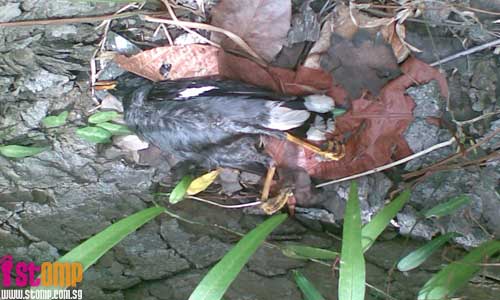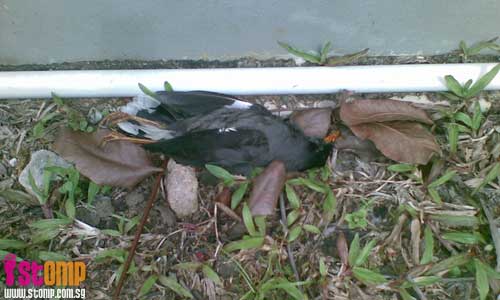
STOMPer Victor wonders whether these birds could have died of a deadly disease, such as the bird flu, and hopes that the relevant authorities will look into the cause.
He says:
"My family and I were walking towards the market at the Taman Jurong area, when we found dead birds lying beside a tree near the carpark.
"It might not look serious, but what if the birds died from diseases such as the bird flu? No one has come over to clean up the bodies of the birds even after two days."


This is definitely not the first time such an incident has been reported in STOMP. In 2007, a similar case in Ang Mo Kio was posted. It's amusing to see how people readily express their concerns about avian flu, when there are often more plausible causes.
In this case, only a single species, the Javan mynah (Acridotheres javanicus) is impacted. It's highly unlikely that only Javan mynahs would be affected if avian flu was involved; one would be finding carcasses from all sorts of species, including crows, sparrows, pigeons, sunbirds, bulbuls, swallows, swifts, tailorbirds, koels, and so on and so forth, maybe even larger species like egrets, owls and raptors. Pet birds also certainly wouldn't be spared. I'm sure there are valuable lessons to be learned from other countries. One example is how North America is coping with the unexpected arrival of West Nile Virus, with consequences for many species of birds.
I think it's far more likely that these mynahs were unintended casualties of a culling exercise, having consumed poisoned bait that was meant for feral pigeons (Columba livia). Since the Javan mynah is now Singapore's most common bird, and is also an opportunistic scavenger, I would say that this is the most plausible explanation for the death of these birds.
However, I am a little concerned as to whether adequate measures are being taken to prevent other species from becoming collateral damage. Are the people in charge of culling doing enough to ensure that only pigeons take the bait, and not other species? Not only is it completely unnecessary if non-targeted species end up getting poisoned, it's also a waste of poison. Besides, the death of several mynahs might seem inconsequential, but what if threatened species are involved? There are countless examples from all over the world showing how poison baits can take a toll on other species not targeted at all.
I am also a little concerned about the fact that the bird carcasses are not being cleared. What will happen if somebody's pet dog picks up one of these poisoned birds, or if a stray cat scavenges the carcass? If a raptor or owl finds a dying mynah and catches it for food, will the predator be adversely affected as well?
I have never really seen for myself if culling pigeons through the use of poison is effective or not, but it certainly is a cause for concern for two main reasons:
1) That not enough is being done to ensure that only pigeons take the poison bait. The lives of Javan mynahs might seem cheap, but all the same, more ought to be done to prevent other species from consuming the bait. Besides, are there more effective and more humane ways to reduce pigeon numbers?
2) That the carcasses of birds killed by poison are being left around, to pose a potential threat to the survival of other species. Are only pigeon carcasses being cleared, while those of other non-targeted species are left behind?